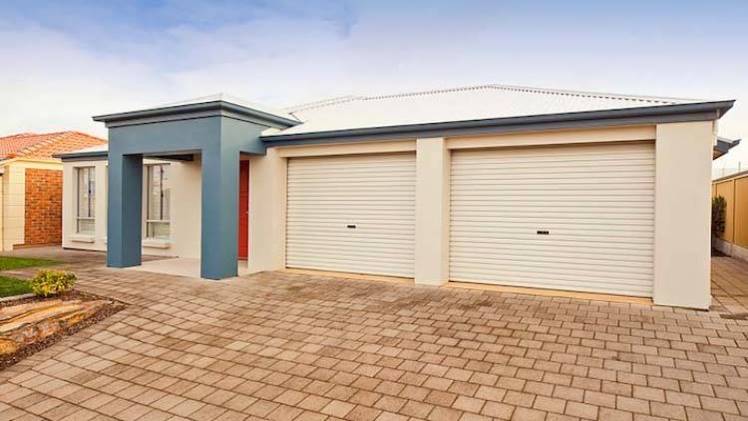The Essential Guide to New Garage Door Installation: A Step-by-Step Process for a Stylish and Functional Upgrade

Key Takeaways:
- Choosing the right garage door style enhances aesthetics and adds value to your property.
- Popular garage door styles include traditional raised-panel, carriage-house, and modern designs.
- Consider architectural style, materials, and functionality when selecting a garage door style.
- Common garage door materials include steel, wood, aluminum, fiberglass, and vinyl.
- Each material has its own pros and cons, such as durability, maintenance, and insulation properties.
- Climate, lifestyle, and long-term goals should be considered when choosing a garage door material.
- Installing a garage door requires preparation, and the decision to hire a professional or DIY depends on experience and tools available.
- Garage doors can be enhanced with features like different opener options, safety features, and smart technology integration.
- Garage door openers can be chain drive, belt drive, or screw drive, each with its own benefits.
- Essential safety features include auto-reverse mechanism, rolling code technology, and manual release handle.
- Smart technology integration allows remote control and monitoring of the garage door for convenience and security.
1. Choosing the Perfect Garage Door Style
When it comes to selecting a new garage door, choosing the right style is crucial. Not only does it enhance the overall aesthetics of your home, but it also adds value to your property. Before diving into the different styles available, take a moment to consider your personal taste, the architectural design of your home, and the overall vibe you want to achieve.
1.1 Exploring Popular Garage Door Styles
Garage doors come in a wide variety of styles, each with its own unique features and charm. One popular option is the traditional raised-panel design. This classic style features several rectangular panels that add depth and dimension to the door. Another popular choice is the carriage-house style, which replicates the look of old-fashioned swing-out doors. This style is perfect for those who want to achieve a rustic or country-inspired aesthetic.
If you prefer a more contemporary look, consider a modern garage door style. These doors often feature sleek lines, glass panel inserts, and minimalist designs. They are commonly made from materials like aluminum, glass, or steel, and they instantly add a touch of modern elegance to any home.
1.2 Factors to Consider in Selecting a Garage Door Style
While exploring different garage door styles, it’s essential to consider several factors to ensure you make the right choice. First and foremost, think about the architectural style of your home. You want your garage door to complement the overall design seamlessly. For example, if you have a colonial-style home, a carriage-house garage door would be a perfect match, whereas a modern-style home would benefit from a contemporary garage door.
Another critical factor to consider is the material of the garage door. Different materials have their own unique characteristics, benefits, and drawbacks. We will explore this topic further in the next section. Additionally, think about the practicality and functionality of the style you choose. Consider factors such as insulation, durability, and maintenance requirements.
1.3 Matching Your Garage Door Style to Your Home’s Architecture
Aesthetically, it’s essential to match your garage door style to your home’s architecture to create a cohesive and visually appealing look. A garage door that clashes with the architectural style can detract from the overall curb appeal and value of your property.
If you have a traditional-style home, opt for garage doors with classic designs like raised panels or carriage-house styles. These styles add a touch of elegance and timeless charm to your exterior. For contemporary or modern-style homes, consider garage doors with clean lines, minimalistic designs, and materials like aluminum or glass to achieve a sleek, sophisticated look.
2. Understanding the Garage Door Materials
Choosing the right material for your garage door is essential for both functionality and aesthetics. Different materials offer varying levels of durability, insulation, maintenance requirements, and price points. Let’s explore the most common garage door materials to help you make an informed decision.
2.1 Comparing Different Garage Door Materials
- Steel: Steel is one of the most popular garage door materials due to its durability and affordability. It is resistant to dents and can withstand harsh weather conditions. Steel doors are available in various styles and finishes, making it easy to find one that matches your home’s architecture.
- Wood: Wooden garage doors offer a timeless and classic look, adding warmth and natural beauty to your home. They can be customized to fit your specific design preferences and are perfect for traditional or rustic-style homes. However, wood requires regular maintenance to prevent warping, cracking, and rotting.
- Aluminum: Aluminum garage doors are lightweight and corrosion-resistant. They are an excellent choice for modern-style homes, as they can be customized with glass panel inserts to create a sleek and contemporary look. However, aluminum is not as durable as steel or wood and may dent easily.
- Fiberglass: Fiberglass garage doors are known for their durability and low-maintenance requirements. They can be designed to resemble wood grain textures and offer excellent insulation properties. However, fiberglass doors may fade over time with exposure to sunlight.
- Vinyl: Vinyl garage doors are highly durable and require minimal maintenance. They are resistant to dents, scratches, and rust. Vinyl doors also offer good insulation properties, making them energy-efficient. These doors come in a variety of colors and finishes to suit any home style.
2.2 Pros and Cons of Each Garage Door Material
- Steel: Pros – affordable, durable, low maintenance; Cons – can dent if hit hard, may require insulation for temperature control.
- Wood: Pros – classic and elegant look, customizable, good insulation; Cons – requires regular maintenance, susceptible to rot and warping.
- Aluminum: Pros – lightweight, customizable with glass panels, modern appearance; Cons – less durable than steel or wood, prone to dents.
- Fiberglass: Pros – durable, low maintenance, excellent insulation; Cons – may fade over time.
- Vinyl: Pros – highly durable, low maintenance, excellent insulation, resistant to dents and rust; Cons – limited style options.
2.3 Determining the Best Material for Your Climate and Lifestyle
When choosing a garage door material, it’s important to consider your climate and lifestyle factors. For example, if you live in an area with extreme weather conditions, such as excessive heat or heavy snowfall, you’ll want a material that can withstand these elements.
If you live in a coastal area, you’ll need a material that is highly resistant to corrosion from saltwater and humidity. On the other hand, if you have a busy household with active children or pets, you might want a material that is more resistant to dents and scratches.
Take into account your long-term goals and budget as well. While wood doors may require more maintenance, they offer timeless beauty that can significantly enhance the value of your home. On the other hand, if budget and low maintenance are your top priorities, steel or vinyl doors might be the best options for you.
3. The Step-by-Step Process of Garage Door Installation
Installing a garage door may seem like a daunting task, but with the right tools and techniques, it can be a straightforward process. Whether you choose to hire a professional or tackle it as a DIY project, understanding the step-by-step process is essential.
3.1 Preparing the Garage for Installation
Before installing the new garage door, there are a few essential preparations to make. Start by clearing out any items stored in the garage to create a safe and clutter-free working space. Remove the old garage door, tracks, and hardware if necessary.
Inspect the garage walls and ceiling for any signs of damage or structural issues. Repair any cracks or weak spots to ensure the safety and stability of the garage. Additionally, check the opening for proper measurements to ensure a proper fit for the new door.
3.2 Professional vs. DIY Installation: Which Option is Right for You?
Deciding whether to hire a professional or install the garage door yourself depends on several factors. If you have experience with similar home improvement projects and feel confident in your abilities, a DIY installation might be a cost-effective option. However, keep in mind that garage door installation requires expertise and specialized tools.
If you are unsure about the installation process or lack the necessary skills and tools, it is advisable to hire a professional garage door installer. They have the knowledge and experience to ensure a proper and efficient installation, reducing the risk of potential problems or safety hazards in the future.
3.3 Installing the Garage Door: Tools and Techniques
Whether you choose DIY installation or hire a professional, certain tools and techniques are essential for a successful garage door installation. Common tools include a drill, level, tape measure, socket set, and wrenches. Additionally, safety equipment such as gloves and safety glasses are crucial to protect yourself during the installation process.
The installation process typically involves attaching the vertical and horizontal tracks to the garage walls, installing the springs and cables, hanging the panels, and connecting the opener system. It is crucial to follow the manufacturer’s instructions and guidelines carefully, as each garage door model may have specific requirements.
4. Enhancing Functionality and Safety Features
A new garage door installation is not only an opportunity to enhance the style of your home but also to improve its functionality and safety. Modern garage doors come with a range of additional features and options that can make your daily life more convenient and secure.
4.1 Understanding Garage Door Opener Options
The garage door opener is an integral part of the functionality of your garage door. There are several types of garage door openers available:
– Chain Drive: This type of opener uses a metal chain to lift and lower the garage door. It is a reliable and affordable option but tends to be louder than other types.
– Belt Drive: Belt drive openers use a rubber belt to operate the garage door. They are known for their quiet operation and are an excellent choice for homes with living spaces above or adjacent to the garage.
– Screw Drive: Screw drive openers use a threaded steel rod to lift and lower the door. They are known for their reliability and require minimal maintenance.
When choosing a garage door opener, consider factors such as noise level, speed, and additional features like remote access or smart technology integration.
4.2 Essential Safety Features to Consider
Garage door safety should be a top priority when choosing a new garage door. Look for doors that come equipped with essential safety features such as:
– Auto-Reverse Mechanism: This feature ensures that the garage door automatically reverses its direction if it detects an obstruction, preventing accidents or damage.
– Rolling Code Technology: Garage doors with rolling code technology generate a new access code every time the door is operated, making it more challenging for potential burglars to gain unauthorized access to your home.
– Manual Release Handle: In case of a power outage or emergency situation, a manual release handle allows you to disengage the opener and operate the garage door manually.
4.3 Smart Technology Integration for Convenience and Security
Smart technology has revolutionized the way we interact with our homes, and garage doors are no exception. Consider garage door opener systems that offer smart technology integration, allowing you to control and monitor your garage door remotely through a smartphone app.
With smart technology, you can receive real-time notifications when the garage door is opened or closed, provide temporary access to guests or delivery personnel, and even integrate it with other smart home devices for enhanced security and convenience.
By choosing a garage door with smart technology integration, you can enjoy peace of mind, convenience, and seamless control over your garage door, even when you’re away from home.
Installing a new garage door is a significant home improvement project that can transform the look and functionality of your property. By carefully selecting the right style, material, and features, and following the proper installation process, you can achieve a stylish and functional upgrade that enhances the value of your home. Take the time to explore your options and consult with professionals to ensure a successful garage door installation process.
FAQ
Question: What are the popular garage door styles? Answer: The popular garage door styles include traditional raised-panel, carriage-house, and modern designs.
Question: How do I choose the perfect garage door style? Answer: To choose the perfect garage door style, consider your personal taste, the architectural design of your home, and the overall vibe you want to achieve.
Question: What factors should I consider when selecting a garage door style? Answer: When selecting a garage door style, consider the architectural style of your home, the material of the garage door, and the practicality and functionality of the style you choose.
Question: How do I match my garage door style to my home’s architecture? Answer: To match your garage door style to your home’s architecture, opt for classic designs like raised panels or carriage-house styles for traditional-style homes. For contemporary or modern-style homes, choose garage doors with clean lines and minimalistic designs.
Question: What are the common garage door materials? Answer: The common garage door materials include steel, wood, aluminum, fiberglass, and vinyl.
Question: What are the pros and cons of each garage door material? Answer: 1. Steel: Pros – affordable, durable, low maintenance; Cons – can dent if hit hard, may require insulation for temperature control. 2. Wood: Pros – classic and elegant look, customizable, good insulation; Cons – requires regular maintenance, susceptible to rot and warping. 3. Aluminum: Pros – lightweight, customizable with glass panels, modern appearance; Cons – less durable than steel or wood, prone to dents. 4. Fiberglass: Pros – durable, low maintenance, excellent insulation; Cons – may fade over time. 5. Vinyl: Pros – highly durable, low maintenance, excellent insulation, resistant to dents and rust; Cons – limited style options.
Question: How do I determine the best garage door material for my climate and lifestyle? Answer: When determining the best garage door material, consider your climate, such as extreme weather conditions or coastal areas, and your lifestyle factors, such as the presence of children or pets.
Question: Should I hire a professional or install the garage door myself? Answer: Whether to hire a professional or install the garage door yourself depends on your experience, skills, and tools available. If unsure, it is advisable to hire a professional garage door installer.
Useful Resources:
- This Old House – Choosing a Garage Door
- Overhead Door Company – Different Garage Door Styles
- The Home Depot – Garage Door Materials
- Bob Vila – Choosing the Right Garage Door
- Family Handyman – Tips for Replacing Your Garage Door
- Home Stratosphere – Garage Door Styles for Different Home Architectures
- Angie’s List – How to Choose the Best Garage Door Material
- Luxury Portfolio – Ultimate Guide to Choosing a Garage Door



